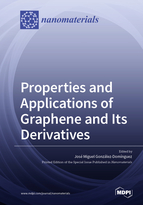Properties and Applications of Graphene and Its Derivatives
A special issue of Nanomaterials (ISSN 2079-4991). This special issue belongs to the section "2D and Carbon Nanomaterials".
Deadline for manuscript submissions: closed (31 July 2021) | Viewed by 59225
Special Issue Editor
Interests: graphene; carbon nanotubes; nanocomposites; nanomaterials processing; chemical functionalization; structural applications; (bio)sensing; nanomedicine; sustainability
Special Issue Information
Dear Colleagues,
Graphene is a two-dimensional, one-atom-thick material made entirely of carbon atoms, arranged in a honeycomb lattice. Because of its distinctive mechanical (e.g., high strength and flexibility) and electronic (great electrical and thermal conductivities) properties, graphene is an ideal candidate in myriad applications. Thus, it has just started to be engineered in electronics, photonics, biomedicine, and polymer-based composites, to name a few. The graphene family is even wider, and includes other members such as graphene oxide (GO), reduced GO (rGO), or graphene quantum dots (GQDs), which are also very interesting materials, whose properties (markedly different from those of pristine graphene) are under thorough study. Understanding the properties of the graphene family of nanomaterials is crucial for developing advanced applications to solve important challenges in critical areas such as energy and health.
This Special Issue aims at gathering original research works in which the excellent properties of graphene nanomaterials are exploited in cutting-edge applications. These include, but are not limited to, optoelectronics, nanomedicine, structures, energy, transport, sensing or environment and sustainability applications. Papers on graphene hybrid nanostructures, doped, or functionalized graphene derivatives are also welcome.
Dr. José Miguel González-Domínguez
Guest Editor
Manuscript Submission Information
Manuscripts should be submitted online at www.mdpi.com by registering and logging in to this website. Once you are registered, click here to go to the submission form. Manuscripts can be submitted until the deadline. All submissions that pass pre-check are peer-reviewed. Accepted papers will be published continuously in the journal (as soon as accepted) and will be listed together on the special issue website. Research articles, review articles as well as short communications are invited. For planned papers, a title and short abstract (about 100 words) can be sent to the Editorial Office for announcement on this website.
Submitted manuscripts should not have been published previously, nor be under consideration for publication elsewhere (except conference proceedings papers). All manuscripts are thoroughly refereed through a single-blind peer-review process. A guide for authors and other relevant information for submission of manuscripts is available on the Instructions for Authors page. Nanomaterials is an international peer-reviewed open access semimonthly journal published by MDPI.
Please visit the Instructions for Authors page before submitting a manuscript. The Article Processing Charge (APC) for publication in this open access journal is 2900 CHF (Swiss Francs). Submitted papers should be well formatted and use good English. Authors may use MDPI's English editing service prior to publication or during author revisions.
Keywords
- graphene derivatives
- processing and production
- chemical and physical properties characterization
- applications in critical fields (energy, optoelectronics, biomedicine, sensing structures, environment, etc.)







